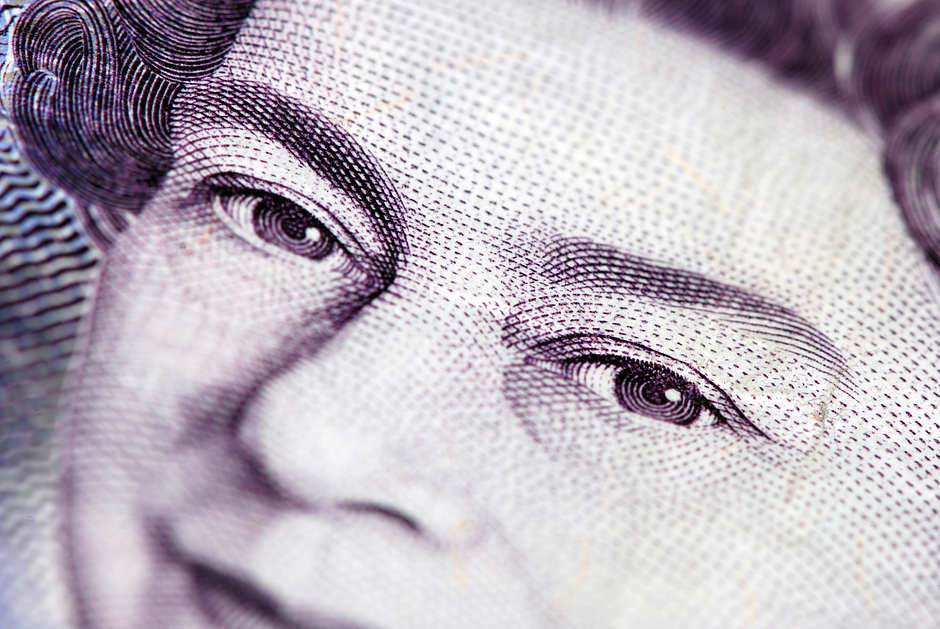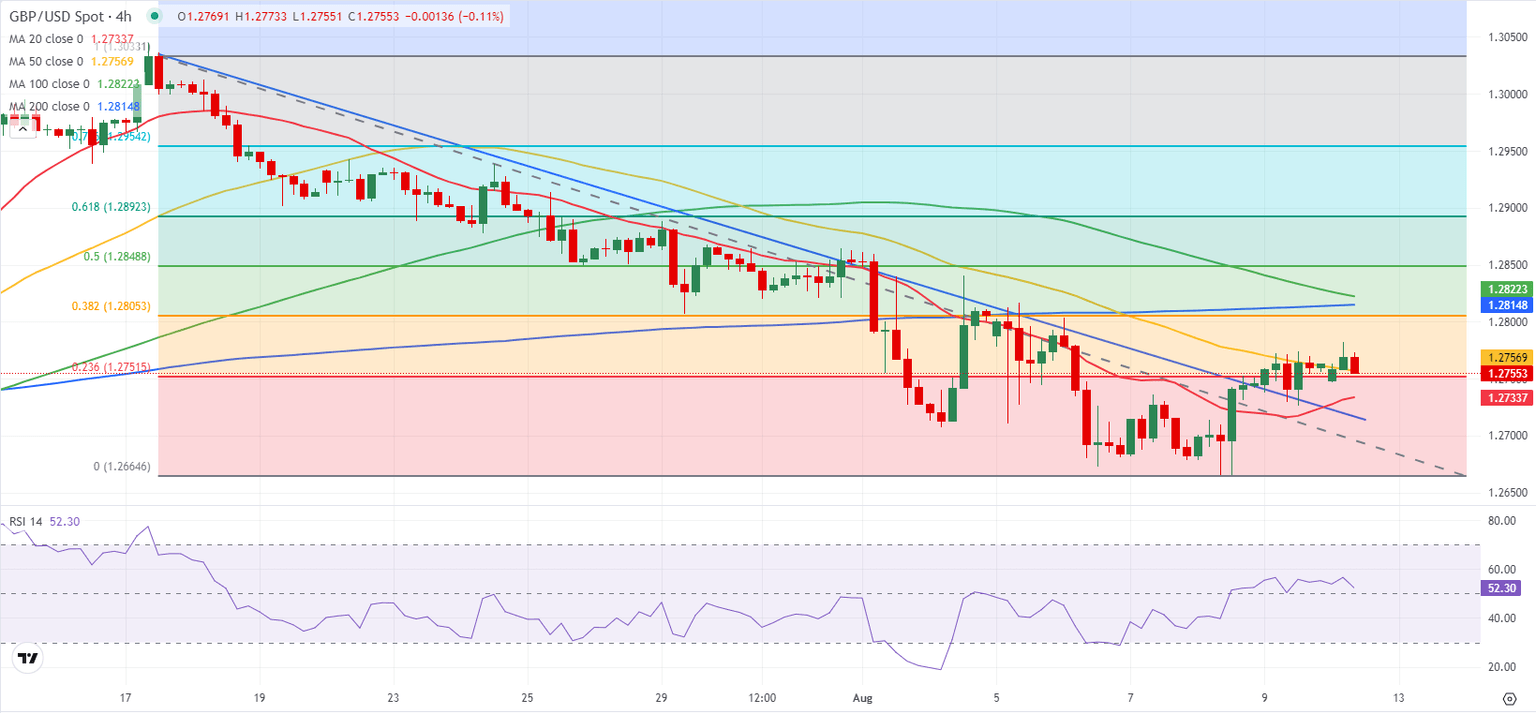GBP/USD Forecast: Pound Sterling struggles to extend rebound
- GBP/USD fluctuates slighlty above 1.2750 in the European session on Monday.
- Escalating geopolitical tensions cause investors to stay away from risk-sensitive assets.
- The pair's near-term technical outlook is yet to point to a buildup of recovery momentum.

GBP/USD posted gains for the second consecutive day on Friday but ended up closing the week in negative territory. The pair stays relatively quiet in the European session on Monday and trades in a narrow band slightly above 1.2750.
British Pound PRICE Last 7 days
The table below shows the percentage change of British Pound (GBP) against listed major currencies last 7 days. British Pound was the weakest against the New Zealand Dollar.
| USD | EUR | GBP | JPY | CAD | AUD | NZD | CHF | |
|---|---|---|---|---|---|---|---|---|
| USD | -0.08% | 0.40% | 0.49% | -1.02% | -1.28% | -1.24% | 1.18% | |
| EUR | 0.08% | 0.39% | 0.42% | -1.07% | -1.19% | -1.27% | 1.15% | |
| GBP | -0.40% | -0.39% | 0.08% | -1.43% | -1.57% | -1.65% | 0.76% | |
| JPY | -0.49% | -0.42% | -0.08% | -1.46% | -1.80% | -1.70% | 0.72% | |
| CAD | 1.02% | 1.07% | 1.43% | 1.46% | -0.23% | -0.22% | 2.04% | |
| AUD | 1.28% | 1.19% | 1.57% | 1.80% | 0.23% | -0.08% | 2.37% | |
| NZD | 1.24% | 1.27% | 1.65% | 1.70% | 0.22% | 0.08% | 2.45% | |
| CHF | -1.18% | -1.15% | -0.76% | -0.72% | -2.04% | -2.37% | -2.45% |
The heat map shows percentage changes of major currencies against each other. The base currency is picked from the left column, while the quote currency is picked from the top row. For example, if you pick the British Pound from the left column and move along the horizontal line to the US Dollar, the percentage change displayed in the box will represent GBP (base)/USD (quote).
Several news outlets reported over the weekend that Israel was on high alert, expecting an imminent from Iran. Meanwhile, Israel Defense Forces said that intercepted about 30 "projectiles" that were crossing from Lebanon into northern Israel.
The cautious market mood on growing fears over a deepening crisis in the Middle East cause investors to stay away from risk-sensitive assets, helping the US Dollar (USD) stay resilient against its rivals and making it hard for GBP/USD to extend its recovery.
On Tuesday, the UK's Office for National Statistics (ONS) will release employment data. More importantly, the Consumer Price Index (CPI) data from the UK and the US on Wednesday will be watched closely by market participants. Hence, GBP/USD could struggle to find direction ahead of inflation figures.
Nevertheless, GBP/USD could stay on the back foot if a further escalation in geopolitical tensions forces investors to seek refuge.
GBP/USD Technical Analysis
The Relative Strength Index (RSI) indicator on the 4-hour chart stays flat near 50, pointing to a lack of bullish momentum even though GBP/USD holds above the descending trend line coming from mid-July.
On the upside, strong resistance area seems to have formed at 1.2800-1.2810, where the 200-period Simple Moving Average (SMA) and the Fibonacci 38.2% retracement of the latest downtrend are located, before 1.2850 (Fibonacci 50% retracement) and 1.2900 (Fibonacci 61.8% retracement).
If 1.2750 (Fibonacci 23.6% retracement) support fails, additional losses toward 1.2700 (psychological level, static level) and 1.2660 (end point of downtrend) could be seen.
Pound Sterling FAQs
The Pound Sterling (GBP) is the oldest currency in the world (886 AD) and the official currency of the United Kingdom. It is the fourth most traded unit for foreign exchange (FX) in the world, accounting for 12% of all transactions, averaging $630 billion a day, according to 2022 data. Its key trading pairs are GBP/USD, aka ‘Cable’, which accounts for 11% of FX, GBP/JPY, or the ‘Dragon’ as it is known by traders (3%), and EUR/GBP (2%). The Pound Sterling is issued by the Bank of England (BoE).
The single most important factor influencing the value of the Pound Sterling is monetary policy decided by the Bank of England. The BoE bases its decisions on whether it has achieved its primary goal of “price stability” – a steady inflation rate of around 2%. Its primary tool for achieving this is the adjustment of interest rates. When inflation is too high, the BoE will try to rein it in by raising interest rates, making it more expensive for people and businesses to access credit. This is generally positive for GBP, as higher interest rates make the UK a more attractive place for global investors to park their money. When inflation falls too low it is a sign economic growth is slowing. In this scenario, the BoE will consider lowering interest rates to cheapen credit so businesses will borrow more to invest in growth-generating projects.
Data releases gauge the health of the economy and can impact the value of the Pound Sterling. Indicators such as GDP, Manufacturing and Services PMIs, and employment can all influence the direction of the GBP. A strong economy is good for Sterling. Not only does it attract more foreign investment but it may encourage the BoE to put up interest rates, which will directly strengthen GBP. Otherwise, if economic data is weak, the Pound Sterling is likely to fall.
Another significant data release for the Pound Sterling is the Trade Balance. This indicator measures the difference between what a country earns from its exports and what it spends on imports over a given period. If a country produces highly sought-after exports, its currency will benefit purely from the extra demand created from foreign buyers seeking to purchase these goods. Therefore, a positive net Trade Balance strengthens a currency and vice versa for a negative balance.
Premium
You have reached your limit of 3 free articles for this month.
Start your subscription and get access to all our original articles.
Author

Eren Sengezer
FXStreet
As an economist at heart, Eren Sengezer specializes in the assessment of the short-term and long-term impacts of macroeconomic data, central bank policies and political developments on financial assets.


















